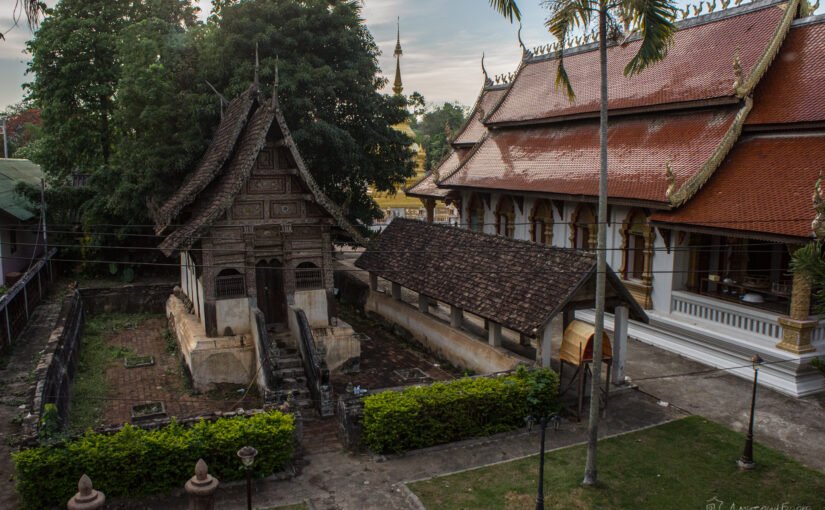Since we accidentally accidentally found it, wandering through the already semi-rural streets on the very outskirts of Chiang Mai, we call it “The smallest temple” (although sometimes we call it “The most charming”). Indeed, I did not see less. Although I read that the real “Thailand’s smallest temple” is located in the province of Nan and has a size of 2×2.5 meters. It looks more like a house for spirits, which is probably why we did not recognize it when traveling around Nan. It was built “for order” before the king visited the city, when it detected that there were 499 temples in Nan, but they wanted 500.
Ours is a bit bigger, 6 meters in length. But it stands opposit a big new viharn, and in comparison with it you can see how tiny this baby is.
It is known from the documents that the monks began to retire here, in the forest, far from the then nearest village, from the end of the 16th century. When the nearest settlements began to expand and reached this place, they decided to build a temple here. In the middle of the 17th century, the ruler allocated an area of 14×10 meters for the construction. Sometimes the “smallest” is called as 400-years old, but this is not so. The current building appeared in 1847. For wooden Thai temples – also great age, they rarely live up to this.
The name of the monastery, on the territory of which this temple stands today, is unexpected too: Wat Ubosot. Ubosot is one of the main buildings in a Buddhist monastery, where initiation into monks and other sacraments takes place. Sometimes the entrance to the laity is forbidden there, and sometimes – only to women. So the name sounds something like “temple Temple”.
It was built in the classical northern “Lann” traditions: a stone plinth, a wooden top, a “flying” roof with horns – everything is with him. Due to its diminutiveness, it is very clearly seen that it is “framework”: the load-bearing frame of wooden beams is laid with plastered brick walls. A charming and also very traditional wooden carved facade interspersed with multi-colored glass and tarnished mirrors.
The building is very lopsided, which is probably why it is always locked. Once the monks nevertheless allowed me to look inside. There is a simple whitewashed room, a small altar with traditional stucco work, and several simple statues of the Buddha.
This place is still on the outskirts, nearby are the fields of the university agricultural faculty and a large farm with cows, although the area already belongs to the city. It’s quiet and nice.
Once, when we riding around the neighborhood, once again looked here, young monks were digging a hole in the yard. A large scorpion crawled out of the bushes towards them. I shouted to them to be careful – their legs are bare! Seeing the beast, they were terribly amused and began to play with it with a stick. Then they pushed him back into the bushes and harnessed to a cart loaded with earth, fooling around and laughing, rolled it somewhere on the back.
